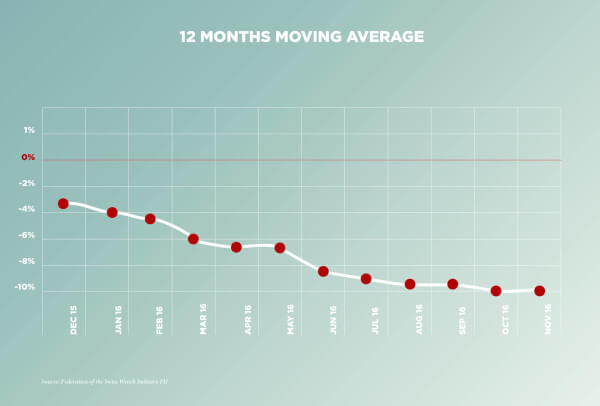Traditionally, December is the season of goodwill, a time to thank those around us for efforts made and boost morale for the twelve months to come. Not so this year. As 2016 draws to a close, there is more trading of insults than warm wishes. The air is thick with criticism and harsh words. Criticism of suppliers, incapable of doing a good job; criticism of retailers, trapped by a glut of inventory; criticism of clients, fickle and disdaining; criticism of brands, accused of fuelling the grey market; and criticism of short-term management, lured by the siren’s song, like Ulysses, lashed to a once solid mast that now bends and sways. The watch industry has hit a wall. The downward trend in exports over the past eighteen months should be enough to convince anyone, all the more so as this has been a far more slippery slope than anticipated. And so the natural reaction is to point the finger of blame.
From quotidian object fifty years ago, the good old watch has become a vector for the emotions, an heirloom and a symbol of who we are.
Deciding where the buck stops shouldn’t be a problem; after all, the facts are well-known. From an economy in meltdown to currency losses or collapsing sales to Hong Kong, not a stone has been left unturned; every angle has been scrutinised, analysed, chastised even. Such peaks and valleys aren’t rare in watchmaking’s long existence. The guardians of time have hit far bigger bumps in the road and survived; why then are they not better immunised against market viruses? How many storms has the sector weathered, head held high? One need think no further back than the fallout from the subprime crisis, when brands went on to parade triumphant across the globe. But the trumpets have fallen silent. Word is that the industry is facing a crisis potentially as damaging as the onslaught of quartz in the late 1970s, given Swiss brands’ inability to rise to the smartwatch challenge. Suppliers, retailers, clients, brands, management are all thrown in together, and no-one comes out unscathed.

A product that knows no bounds
Dire straits? Probably, although the reasons assigned to this latest setback are not the usual suspects. Amidst all the doom and gloom, are not enlightened voices heard, astonished by this talk of crisis? More to the point, how is it possible for watchmaking to wake up with a thumping pre-Christmas “hangover”, having reached such dizzying heights not so very long ago. The industry has come down to earth with a bump. But what other possible outcomes were there? Having achieved the exploit of saving the mechanical watch from oblivion in the late ’90s, brands were on a roll. Eyes riveted on the top of the pyramid with its juicy margins, they went all out to give their timepieces the luxury seal of approval. From quotidian object fifty years ago, the good old watch has become a vector for the emotions, an heirloom and a symbol of who we are. In other words, an exceptional product that knows no bounds, including pecuniary.
Electronics are the world's steeple, and the aesthete adorns his wrist with a watch that, in many cases, by far exceeds the value of his car.
Why not indulge a public that only wants more? Why not continue to expand into seemingly limitless territories, particularly in the East? Over the course of a decade, watches thus became more technical, more complicated, more exclusive, more imposing, more expensive, more… As though horology had returned to its roots, the preserve of the wealthy and influential classes, leaving the populace with nothing more than some vague steeple to locate them in time. In today’s world, where children learn to tell the big hand from the little hand at the same time as they learn the alphabet, electronics are the world’s steeple, and the aesthete adorns his wrist with a watch that, in many cases, by far exceeds the value of his car, and possibly even approaches that of his house. Yes, but this kind of watch is a little piece of eternity, we are told. Why not. Has eternity become so very elitist? Hardly surprising, then, that watchmakers should have lost some of their following along the way. The dream became an illusion. Now it’s a nightmare.
A new balance of power
Even with the addition of finely executed métiers d’art – the companion crafts that bring “extra soul” to inspired mechanics – watchmaking is no less an industrial activity par excellence. Without this cutting-edge industrial base, which incidentally must be maintained, the mechanical measuring of time would be a marginal practice, left to a handful of eccentrics versed in kinetic sculpture; an Indian reservation rather than Switzerland’s third largest export industry. As it is, and given its status, watchmaking’s doubtless many assets proved so compelling that the Swiss mechanical watch became unchallenged across the globe, and those that make it became kings in their own country, the rulers of time. Yet we all know what happens to autocracies, not to say plutocracies. Sooner or later there is a rumble of discontent, a stirring in the ranks, the first signs of rebellion. A turning-point is reached, and an intelligent strategy is the only possible response.
After hiding their heads under their wings until brighter days, brands have something to invent that has nothing to do with gear ratios or constant force.
As we say goodbye to 2016, watchmakers have realised not everyone is willing to climb aboard their flying carpet. Shunned by customers left cold by grinning stars who hire out their wrists, customers unable to identify with trade fairs where any visitor not strapped into a three-piece suit looks out of place, brands must learn to listen again, so as to better adapt their offering and adjust their production accordingly. A vast programme. After hiding their heads under their wings until brighter days, brands have something to invent that has nothing to do with gear ratios or constant force. Do they have the means to do so? Definitely. But at a time when we hear more and more about service companies, the democratisation of luxury, social media, e-commerce, authentic products and straight talking, this will take dexterity, patience and a return on investment that focuses first and foremost on the watch buyer, not the shareholder. Maybe 2017 will be his year after all!












